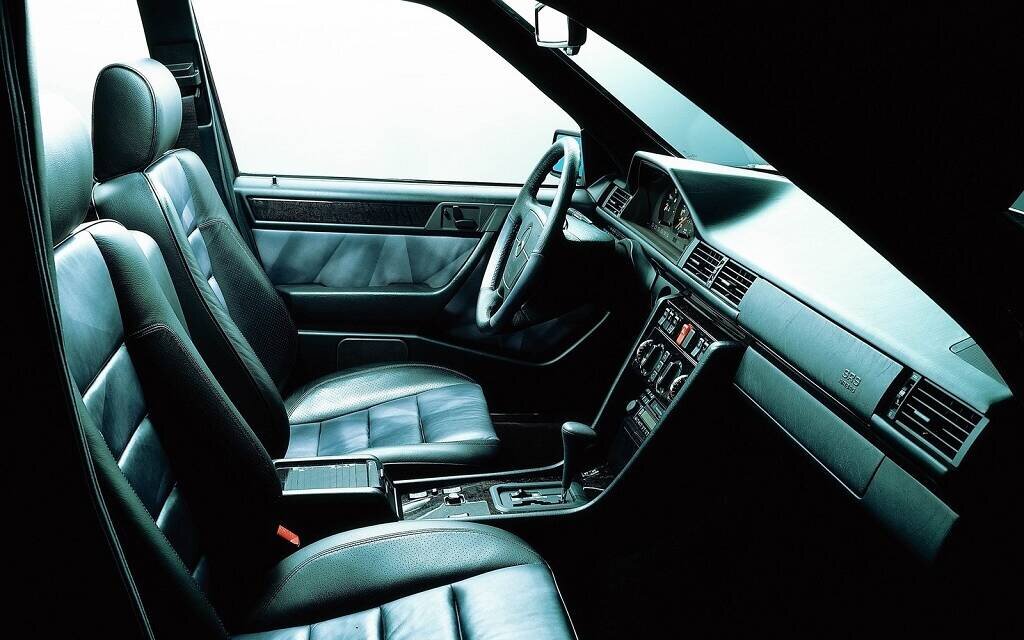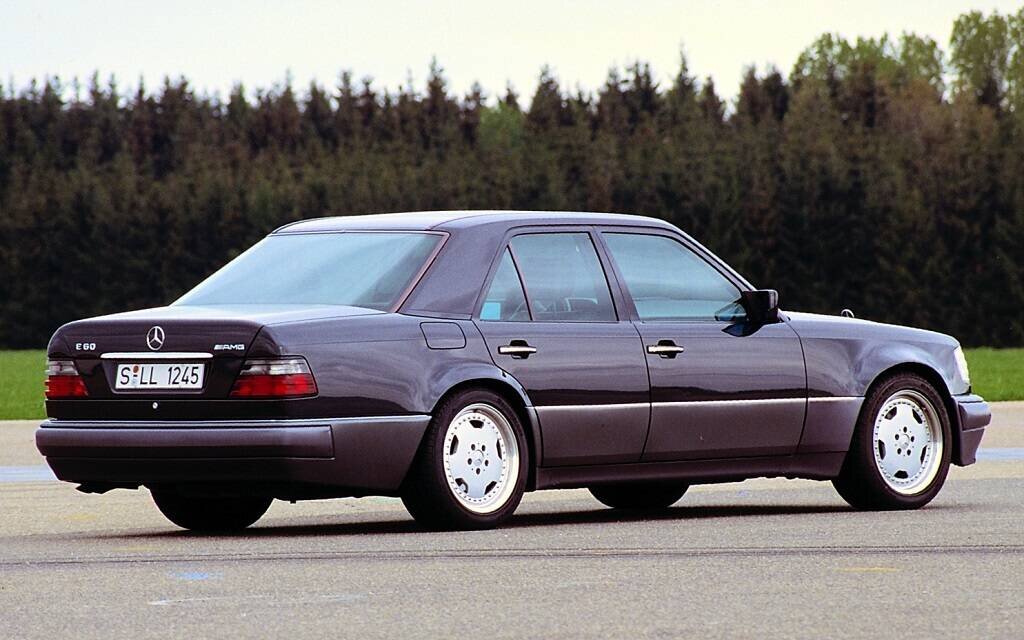At the end of the 1980s, the fight between Mercedes-Benz and BMW was well underway and the existence of the M5 deeply annoyed the star manufacturer. And then there are the German car customization houses that are making handsome profits with their supercharged models. It might be time to react!
If AMG is today the sports branch of Mercedes-Benz, it began as a customizer and preparer of racing cars in 1967. It was not until 1993 that the two companies came together. Mercedes bought 51% of AMG in 1999 before acquiring all of it in 2005. As for the Stuttgart brand, it has already tried its hand at designing models that are a little more saucy than the diesel taxis for which it is then recognized. We think of the 300 SEL 6.3 (from 1968 to 1972, produced in 6,526 units) using the V8 M100 of the Mercedes 600 and the 450 SEL 6.9 (from 1975 to 1981, produced in 7,380 units) with a rebored version of the M100.
Photo: Mercedes-Benz
W124
However, the bread and butter of the brand remain solid cars, intended to cut down the kilometers. The 190, code W201 and nicknamed “Baby Benz”, was just launched in September 1982. With it, Mercedes unveiled a new stylistic language, developed by Bruno Sacco. This design will be used on the replacements of the indestructible 200-300 W123, produced from 1976 to 1986, the W124. Technically very advanced for the time, they are considered by many enthusiasts to be the last truly Mercedes “designed like no other car”. This generation will benefit from several bodies (sedan, wagon, coupe, convertible, limousine) and will experience a nice commercial success with 2,562,143 units manufactured from 1985 to 1996. During the first years, the range is based on 4.5 and 6 cylinders online gasoline and diesel. But things will change in 1988…

Photo: Mercedes-Benz
Horses!
Two factors will precipitate this change: the launch of the BMW M5 (E28 of 286 horsepower in 1984 then E34 of 315 horsepower in 1988, European data) and the United States, which requires a V8 engine. There is no question of leaving the field open to competition from Munich or of letting sales slip away in the most profitable market. But Mercedes faces two problems: the W124 has never been studied to receive a V8 and most of the engineers are monopolized on the W140 project (the S Class of 1991) which will be, according to the brand, a monument of engineering (read complexity). What to do? Mercedes could always call on a neighboring company, located in the outskirts of Stuttgart and which has some skills in the design of sports cars…

Photo: Mercedes-Benz
Porsche to the rescue!
At Porsche, in 1988, the atmosphere is panic. Sales collapsed: the company produced only 25,969 vehicles against 48,520 in 1987. The development contract for the V8-powered W124s is a breath of fresh air for the Porsche engineering office, known for carrying out projects for other manufacturers. For Mercedes, this is an opportunity to strengthen ties with the sports car manufacturer. The brand with the star carefully observes what is happening there and will even consider buying it for a time (it will be necessary to wait for the launch of the Boxster in 1996 for Porsche to regain form). The contract signed between the two companies stipulates that Mercedes will be responsible for the design and aerodynamics and Porsche… the rest! The 2758 project starts at Porsche under the direction of Michael Hölscher and will require nearly two years of development.
Porsche redesigned the entire front cradle to be able to slip into it with the shoehorn of the V8s. The block chosen is the 5.0-liter M119, presented at the launch of the 500 SL R129 with the 1989 model year, but in a version with a modified crankcase. A 4.2 liter variant would be introduced in 1992, primarily for the North American market (as the 400E). It offers 326 horsepower and 480 newton meters of torque in Europe or 322 horsepower and 354 lb-ft of torque in North America. Only a 4-speed automatic transmission (W4A 040) is available, simply because Mercedes does not have a manual transmission that can withstand the torque of the V8. Engineers are also modifying the firewall and widening the central tunnel to accommodate larger catalytic converters. The suspensions and brakes also come from the SL R129, resulting in an increase in track of 37 millimeters at the front and 38 at the rear. All this involves fenders widened by 28 millimeters on each side and new bumpers (with integrated fog lamps in the front). Compared to a “normal” 300E, the wheels are 16 inches and the ride height is lowered by 23 millimeters. In order to save space and improve weight distribution, the battery migrates into the boot. Inside, few changes compared to a 300E except for the presence of beautiful Recaro bucket seats… which are also found in the rear, the bulky differential preventing the installation of a classic bench seat .

Photo: Mercedes-Benz
Complicated
Because of the fenders on steroids, Mercedes realizes the 500E is not making it onto the assembly lines at the Sindelfingen plant, which is already running at full capacity. Here again, Porsche is very happy to take on the production contract… which will prove to be complex. 300E bodies in white leave from Mercedes for the Porsche factory in Zuffenhausen, located about thirty kilometers away, in the “Reutter-Bau” building where the Porsche 959s were assembled shortly before. There, all the sheet metal is modified. Then, the cars go back to Sindelfingen to be painted, Mercedes insisting on keeping total control over the quality of the paint. If it’s a 400E, the car stays there, but if it’s a 500E, it goes back to Zuffenhausen, this time to the “Rössle-Bau” building, for the final assembly (mechanical, interior, finish). Finally, the 500Es leave for Sindelfingen for quality control and preparation for delivery. If the manufacture of a 300E requires three days from the first fold of sheet metal to the exit of the chain, that of a 500E requires 18! This will have, as we will see, a major impact on the price of the machine.

Photo: AMG
An iron fist in a velvet glove
The 500E made its first public appearance at the Paris Motor Show in October 1990. Deliveries in Europe would begin a few months later. In North America, it arrives for the 1992 vintage, at the same time as the 400E. In Canada, the 300E is offered at $67,300 and the 400E at $74,500. The 500E asks for $107,500! That’s a lot, especially considering the $77,675 for a manual BMW M5. The 500E nevertheless surprises with its very high performance (speed limited to 250 km/h, 0 to 100 km in 6.1 seconds), its handling/comfort compromise (even if the M5 remains a little more playful) and its ease of use on a daily basis.
The career of the 500E will not experience any major changes. The V8 drops to 315 horsepower for the 1993 model year to better pass pollution standards. The 1994 vintage benefits from a slight restyling and the W124s officially become E-Class. The 500E then becomes E500 (the 400E is called E420) and receives larger brakes, courtesy of the SL600, as well as an Alpine car radio. This is its last year of marketing in North America. For Europe, production continued until April 1995. Mercedes then put on sale a limited series, logically baptized Limited and fitted with 17-inch EVO-II wheels, a specific leather finish and maple wood. . Initially planned for 500 copies, it will finally be sold at 951 copies. Note that AMG will also put its nose under the hood of the 500E by installing a 6.0-liter V8 developing 381 horsepower. The company will build 45 E60s.
The 500E will have been produced in total at 10,479 copies, including 1,528 vehicles for the United States and 45 for Canada. With a good reputation for reliability (if meticulously maintained), it is now sought after by collectors, who consider it to be one of the best sedans in the history of the automobile. When the E-Class W124 will be replaced by the W210, the sports versions will be supplied by AMG (E36, E50, E55, E60 depending on the market). But they won’t leave such strong impressions. Maybe because the W124s are the last Mercedes to be designed as tanks or maybe because they lack the little Porsche touch…
